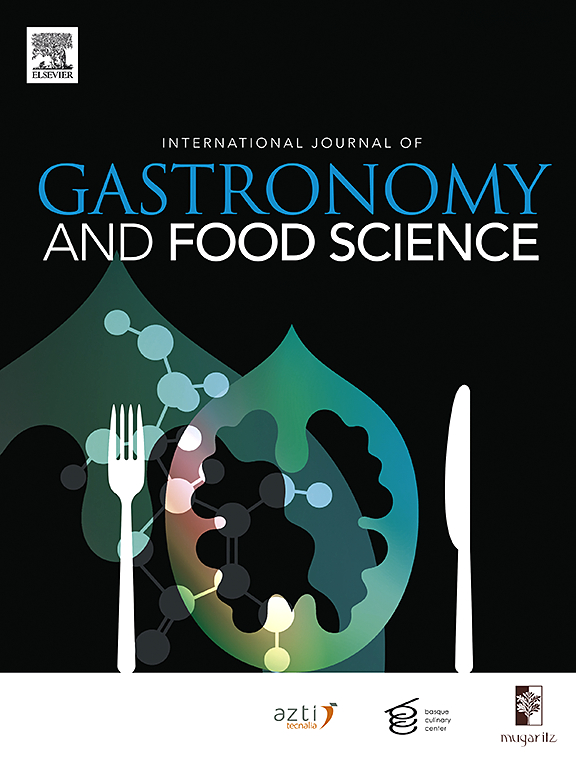Millet processing to fermented drinks: Evaluating changes in nutritional attributes, mineral accessibility, amino acid profile, and sensorial acceptability
IF 3.6
2区 农林科学
Q2 FOOD SCIENCE & TECHNOLOGY
International Journal of Gastronomy and Food Science
Pub Date : 2025-09-11
DOI:10.1016/j.ijgfs.2025.101297
引用次数: 0
Abstract
Fermented drinks form an integral part of our dietary culture. Traditional processing methods can provide a framework that can be used to develop these drinks. In this study, a fermented Indian millet drink Koozh has been studied. Traditionally it is prepared from finger or pearl millet, however in this study three other minor millets varieties i.e. kodo, barnyard and little were also explored to prepare it. Two-way repeated measure ANOVA indicate that millet type, processing and their interaction plays a major role in determining the overall composition of the final drink. Overall fermented millet drinks had high nutritional value, with reduced phytate content (45–93 %). FTIR analysis of the methanolic extract of the drinks showed many functional peaks and the extract was further used to determine the polyphenol content and antioxidant activity (FRAP and DPPH). The millet drinks had high Mg, Fe and Zn content along with essential amino acids particularly isoleucine (16.15–16.85 g/100 free amino acid (FAA)). Mineral analysis reveals that these drinks can be a good source of iron containing approximately 0.15–0.56 mg/100g bio-accessible iron. Principal component analysis (PCA) was employed to identify the key variables contributing to the differences among different millet drinks. Sensorial analysis showed high acceptability among consumers, with barnyard and little millet drinks receiving the highest overall scores. The results from this study indicate that fermented millet drink offer a unique mix of nutritional and functional benefits that needs to be further explored.
谷子加工成发酵饮料:评价营养属性、矿物质可及性、氨基酸分布和感官可接受性的变化
发酵饮料是我们饮食文化中不可或缺的一部分。传统的加工方法可以提供一个框架,可以用来开发这些饮料。本研究以印度小米发酵饮料Koozh为研究对象。传统上,它是由指粟或珍珠粟制成的,然而,在这项研究中,还探索了其他三种较小的粟品种,即kodo,谷仓和little。双向重复测量方差分析表明,小米类型、加工及其相互作用对最终饮料的整体成分起主要作用。发酵小米酒营养价值较高,其中植酸含量降低45 - 93%。利用FTIR对饮料的甲醇提取物进行功能峰分析,测定其多酚含量和抗氧化活性(FRAP和DPPH)。小米饮料具有较高的镁、铁、锌含量,必需氨基酸尤其是异亮氨酸(16.15 ~ 16.85 g/100游离氨基酸(FAA))含量。矿物质分析表明,这些饮料是铁的良好来源,每100克生物可及铁含量约为0.15-0.56毫克。采用主成分分析(PCA)对影响不同谷子饮品口感差异的关键变量进行了分析。感官分析显示消费者的接受度很高,其中谷仓和小小米饮料获得了最高的综合得分。本研究的结果表明,发酵小米饮料提供了独特的营养和功能益处,需要进一步探索。
本文章由计算机程序翻译,如有差异,请以英文原文为准。
求助全文
约1分钟内获得全文
求助全文
来源期刊

International Journal of Gastronomy and Food Science
Social Sciences-Cultural Studies
CiteScore
5.30
自引率
10.50%
发文量
170
审稿时长
45 days
期刊介绍:
International Journal of Gastronomy and Food Science is a peer-reviewed journal that explicitly focuses on the interface of food science and gastronomy. Articles focusing only on food science will not be considered. This journal equally encourages both scientists and chefs to publish original scientific papers, review articles and original culinary works. We seek articles with clear evidence of this interaction. From a scientific perspective, this publication aims to become the home for research from the whole community of food science and gastronomy.
IJGFS explores all aspects related to the growing field of the interaction of gastronomy and food science, in areas such as food chemistry, food technology and culinary techniques, food microbiology, genetics, sensory science, neuroscience, psychology, culinary concepts, culinary trends, and gastronomic experience (all the elements that contribute to the appreciation and enjoyment of the meal. Also relevant is research on science-based educational programs in gastronomy, anthropology, gastronomic history and food sociology. All these areas of knowledge are crucial to gastronomy, as they contribute to a better understanding of this broad term and its practical implications for science and society.
 求助内容:
求助内容: 应助结果提醒方式:
应助结果提醒方式:


